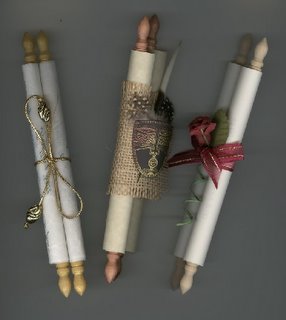
I was looking through all the things I had on my hard drive and found this and thought it might make an interesting read for all my visitors interested in all things green and beautiful.
Landmark and sacred trees of Leicestershire and Rutland
Penny Drayton
Almost universally trees have been venerated and believed to be the dwellings of Tree Spirits, sometimes called Dryads. Deliberately planted groves of sacred trees, such as oak, elder, ash, rowan and hawthorn, were probably the earliest man-made sacred sites. Greek and Roman temples with their columns and decorated capitals may be thought of as an architectural continuation of such groves. Tacitus described the sacred groves in Germany during the Roman period. Closer to home, the importance of tree mythology to the ancient Celts is well-known, in part through Robert Graves' imaginative reconstruction in The White Goddess which explores in detail the tree alphabets and related lore [1].
As late as the eleventh century Cnut was proclaiming laws which prohibited people from owning land which was a sanctuary centred on a tree. St Boniface cursed an oak dedicated to Thunor yet the Old Norse place-name element lundr (meaning '(?sacred) grove' but usually corrupted to 'land' in modern spellings) remains common in England as well as Scandinavia. Many hundred moot places have names ending in '-tree', often prefixed by a personal name, and such names may relate back to the ancient sanctuaries around sacred trees; examples from Leicestershire are given below.
Predictably no trees have survived from pre-christian times and even the Gospel Oaks, where the early missionaries preached, have all gone. The surprisingly abundant evidence for sacred trees comes mostly from place names and folklore as this article will attempt to show, even though it is based only on my researches in Leicestershire and Rutland.
It is worth noting that in Leicestershire the characteristic hedgerow tree is the ash. Oaks and elms have always been less abundant than in most other parts of England. It is difficult to explain this; it may be because the soil conditions were favourable to this species, although there are no surviving woodlands where ash is the predominant species. This part of England was probably largely de-forested before the Roman invasion and all trees and woodland can be regarded as managed rather than natural. Hedgerow trees in particular are usually deliberated planted, or at least deliberately allowed to grow by the hedge trimmer.
Ash makes strong, light timber and excellent fire wood and was no doubt considered a valued species. But could there be deeper reasons for its popularity? It is clear that the ash was sacred to our forefathers - Pliny wrote of their power as protection against snakes and even the shadow cast by an ash was said to be avoided by snakes. The Belgic bronze age invaders apparently worshipped the ash, under the name Gwydion. The Saxons and Danes held ash trees in especial esteem, as Yggdrasill, the Sacred World Tree, was usually described as an ash. Ash is still the favourite wood for walking sticks, a reminder of the tree's power as a sacred ashen spear. Ash was also a favourite herding stick and the proper wood for making shepherds' crooks. A bunch of ash keys was considered a powerful guard against witchcraft.
Whether or not ancient inhabitants of this county encouraged the ash for practical or propitious reasons, they certainly had at least one Great Sacred Grove on the edge of the county. Vernemetum was a Roman town which stood at the crossroads of the Fosse Way and an ancient Salt Way (129:648249) and its name means 'Great (or Especially) Sacred Grove'. This suggests that the site was sacred in late iron age times, presumably being a Druidic grove. Although little archaeological investigation has taken place and nothing is known of its role in the Roman period the site was still important in the later Saxon period as the eighteenth century antiquarian, Stukely, refers to a legend of the ruins of a Saxon church standing in a place known as The Wells. Recent finds by metal detector users seem to confirm the site. On the ridge of the hill, at the crossroads itself, several Saxon barrows were excavated in the 1960s, although the excavation reports have not so far been published.
Moots at trees
As has already been suggested, ancient moot sites may be the last vestiges of ancient sacred enclosures based on tree worship. Towards the south of the county the now-obsolete administrative area of the Gartree Hundred derived its name from geirtre which means 'a tree with an overgrown gash or goitre' - a useful landmark for a moot place. Indeed, throughout Britain '-tree' is a very common part of Hundred names and Leicestershire is certainly no exception. The meeting place of the Sparkenhoe Hundred was probably at Shericles Farm near Desford (140:467026), which derives from scirac meaning "the hundred oak". Another moot took place in Oadby at a place called Spelthorn - 'a thorn where speeches are made'. Framland Hundred derives from 'Faena's grove', which is almost certainly the wood still surviving north of Melton Mowbray at 129:747224. The earlier interpretation of lundr as 'sacred grove' has recently been dismissed by Margaret Gelling, a notable expert on place-names, who interprets the word as simply 'small wood'. Another example of lundr in Leicestershire is Swithland (129:5412); Gelling attributes this to 'burnt-clearing wood' [2].
The meeting place of the Gartree Hundred was well-known as late as the end of the eighteenth century when Nichols described the 'Gartree Bush' in detail. It was situated just to the north of the Roman Road known as Gartree Road and west of the ancient ridgeway running north-south (141:716974)
There is a second Gartree name in Leicestershire, Gartree Hill south of Melton Mowbray (129:760145). Presumably this too was marked by a 'goitred' tree which once had particular significance as a landmark - the hill forms part of the ancient trackway running directly north-south between the hill fort at Burrough on the Hill (761120) and Melton Mowbray.
Oaks
The splendidly suggestive village name of 'Holy Oaks' relates to a now-deserted village south of Stockerston (141:845956). Nothing is known of the origins of this place-name.
Three Shire Oak marked the boundary of Leicestershire, Lincolnshire and Nottinghamshire (130:822429). On earlier maps it is shown as 'Three Shire Bush'. Originally there was also a standing stone here, called the 'Star Stone' which was reputed to have fallen from the sky.
Copt Oak in Charnwood takes its name from a pollarded oak which stood until 1855 in the corner of the churchyard (129:483128). It was said to be two thousand years old. Certainly it was the meeting place for the old forest swanimotes and later was a Civil War rallying point. The church and churchyard are merely nineteenth century intrusions on the site.
White's Directory for 1864 said it was fashioned in the form of a 'Tau' by careful removal of all branches except two. The trunk was said to be 20 feet tall and more than 21 feet in circumference. However an early nineteenth century illustration in Nichols shows only a hollow trunk with small branches growing out of it in a natural manner.
There was at least one other Copt Oak in the county. There is a farm of this name near to Narborough (140:531978).
Abbot's Oak is the name of what is know a farm to the north of Bardon Hill (129:463143) and just up the road from Copt Oak in Charnwood.
In the churchyard of St Peter's, Belgrave (140:5907) was an extremely ancient oak called 'Main Oak'. The churchyard is also reputed to be haunted by a white lady.
When the so-called "nine day's queen", Lady Jane Grey (who actually reigned for thirteen days), was beheaded the oaks at her home in Bradgate Park (129:5311) were reputedly pollarded as a sign of mourning.
An oak was planted in front of the rectory in Burton Overy (141:6798) at the Restoration from an acorn of the famous Boscabel oak. A near neighbour was grown from its acorn on the Diamond Jubilee of Victoria; today only this tree survives.
A so-called Domesday Oak stands near Rutland Water at Edith Weston (141:9205). (Also nearby, at Normanton Park Hotel, is one of Britain's oldest cedar trees.)
Other trees
Between Holywell Haw and Nanpantan to the west of Loughborough there used to stand a 'sweating tree'. It was also distinctive because it blossomed twice a year, in spring and autumn.
An ancient hollow elm used to stand in the churchyard at Sileby (129:600152) from under which the vicar is said to have distributed oranges to children on Whit Monday [5]. Interestingly, the eighteenth century engraving in Nichols does not show such a tree; there is no such tree today.
On a map of 1777 a crossroads in the west of the county is shown as 'Hoo Ash'; this is now the centre of Coalville (129:429141) [4].
References
1: R. Graves, The white goddess, Faber, 1961. 2: M. Gelling, Place-names in the landscape, Dent, 1984. 3: P. Devereux, 'The forgotten heart of Albion, pt1' in The Ley Hunter, No.66, pp9-12, 1975. 4: J.D. Welding (ed.), Leicestershire in 1777, Leicestershire Libraries and Information, 1984. 5: R. Palmer, The folklore of Leicestershire and Rutland, Sycamore Press, 1985.
Originally published in Mercian Mysteries No.9 November 1991.
(image placeholder)
At the Edge home page
http://www.indigogroup.co.uk/edge/
Copyright 1991, 1996, 2001. No unauthorised copying or reproduction except if all following conditions apply: a: Copy is complete (including this copyright statement). b: No changes are made. c: No charge is made.
At the Edge / Bob Trubshaw / bobtrubs@indigogroup.co.uk Created April 1996; updated May 1998



